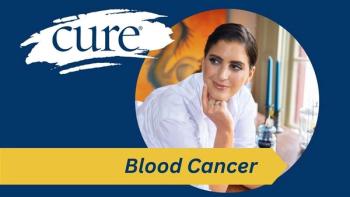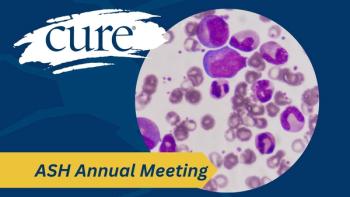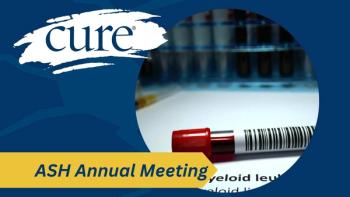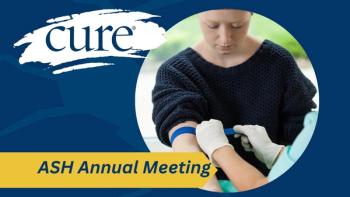
- Hematology 1
- Volume 1
- Issue 1
Extending the Options for Patients with AML by Making It Personal
A wave of new targeted therapies expands the options in acute myeloid leukemia.
In December 2017, Heather Hibbard had just returned home from a weekend getaway in Las Vegas with her family when she noticed she had several massive bruises. Dark, bluish-purple blotches marked her forearm and thigh, and the rest of her body appeared deathly pale.
“As a mother of three, I don’t focus on myself a lot,” says Hibbard, who lives in Yorba Linda, California, and was then 37. “I was having a lot of bone pain in Vegas, but I have scoliosis, so I always have some pain. Everything just multiplied when I got back home.”
She rushed to schedule a same-day appointment with her doctor. As someone in the medical field — she works as an ultrasound technician — Hibbard had no hesitation about learning what could be wrong. Her doctor appeared alarmed about how sick she looked and immediately ordered bloodwork.
Her platelet count was astoundingly low. A normal count ranges from 150,000 to 450,000 platelets per microliter of blood; Hibbard’s hovered around 20,000. She initially assumed something had gone wrong with her intrauterine device, because she had recently experienced heavy vaginal bleeding — abnormal uterine bleeding can be a symptom of certain hematologic cancers.
“I thought I was anemic because I had lost a lot of blood. Cancer didn’t even cross my mind until the doctor came in and told me I had leukemia,” she says.
A week and half after returning from her vacation, Hibbard received a diagnosis of acute myeloid leukemia (AML). This cancer of the blood and bone marrow affects more than 20,000 people each year in the United States.
For years, prognosis remained poor for patients with the disease, which has a 24% five-year survival rate for people ages 20 and older and 67% for those younger than 20, with limited treatment options. But the past two years brought an explosion of new medications approved by the Food and Drug Administration (FDA) to treat AML, particularly therapies targeting specific genomic mutations that may confer a worse prognosis.
“For more than 45 years, the treatment for AML only involved intensive chemotherapy, and that was the only chance at a cure,” says Amer Zeidan, an associate professor of internal medicine at Yale Cancer Center in New Haven, Connecticut. “But since 2017, we’ve had a revolution in the treatment of AML after many years of no approved agents. I give an analogy in (terms) of ‘before Christ’ and ‘after Christ’ because the landscape has changed so much.”
WHAT DOES AN AML DIAGNOSIS MEAN?
Historically, chemotherapy for the treatment of AML involves two phases: induction therapy followed by consolidation therapy. Shortly after diagnosis, a patient will undergo induction therapy to rid the body of any signs of the disease.
Most often, patients receive the combination of cytarabine and an anthracycline drug such as Cerubidine (daunorubicin) or Idamycin (idarubicin). Approximately 75% of younger adults with AML and 50% of patients older than 60 achieve complete remission, or disappearance of overt leukemia in the bone marrow, after induction treatment. Once a patient has recovered, consolidation therapy, chemotherapy or a stem cell transplant kills any remaining leukemia cells.
Early signs of AML, which is typically associated with older age (more than 65 years), history of tobacco smoking and certain inherited genetic disorders, include weight loss, fatigue, fever, night sweats, bruising and excessive bleeding. Because AML is generally widespread throughout the bone marrow and possibly other organs, it is not staged like other cancers. About half of patients who achieve remission after initial treatment will relapse.
Genomic testing revealed that Hibbard had a FLT3 mutation. The most common mutation in AML, FLT3 is found in 30% of all cases and associated with a particularly aggressive form of the disease and a higher risk of relapse. “My oncologist told me, ‘Bad news — you have the FLT3 mutation. But the good news is that they just developed an inhibitor you can take,’” recalls Hibbard. “He said it with a big smile on his face.”
In April 2017, the FDA approved Rydapt (midostaurin), the first targeted therapy for AML, combined with chemotherapy to treat adults with a new diagnosis and a FLT3 mutation. The oral medication belongs to a group of drugs called FLT3 inhibitors, which block several enzymes that promote cell growth.
During Hibbard’s month in the hospital to receive induction chemotherapy, she experienced several life-threatening complications, including a blood clotting disorder, two strokes and a bout of sepsis. Believing she was on her deathbed; she made a video saying goodbye to her children.
Hibbard recovered, returned home and began treatment with Rydapt, which made her nauseated. The drug’s other common side effects include low levels of white blood cells with fever (febrile neutropenia), inflammation of the mucous membranes and vomiting.
Hibbard achieved remission following more chemotherapy and a stem cell transplant and remains free of cancer. “I was extremely excited about taking Rydapt because I felt truly blessed that there was an inhibitor for my mutation, since it was so aggressive,” says Hibbard, who is now 39.
“It smells horrible, and it’s a large pill, but I took it willingly because I knew it would improve my chances of survival.”
RIGHT ON TARGET
Rydapt is one of eight drugs for AML that have gained FDA approval since 2017. Xospata (gilteritinib), another type of targeted therapy that inhibits FLT3, was approved in May
2019 for adults who stopped responding to treatment or whose disease had relapsed.
The IDH inhibitors Idhifa (enasidenib) and Tibsovo (ivosidenib) target mutations in the IDH1 and IDH2 genes. Daurismo (glasdegib), Venclexta (venetoclax) and Vyxeos (CPX-351) expand the options for older patients who can’t be treated with intensive chemotherapy because of its toxicities. Mylotarg (gemtuzumab ozogamicin) can be given to patients who express the CD33 antigen.
“We now have a better understanding of the biology behind AML, especially the molecular mutations that drive this disease, and we have developed treatment that targets these mutations,” says Dr. Kevin Kelly, an associate professor of clinical medicine at the University of Southern California in Los Angeles. “One of the most important mutations is FLT3, targeted by midostaurin and gilteritinib. These drugs specifically target the leukemia cells while being less toxic on the normal tissue of the body.”
In a large clinical trial, patients with new diagnoses who took Rydapt along with chemotherapy lived longer than those who received chemotherapy alone. After four years, 51.4% in the Rydapt group were still alive compared with 44.3% in the chemotherapy group.
Findings from the ADMIRAL trial showed that Xospata similarly extended survival. Patients who took the FLT3 inhibitor alone had a median overall survival of 9.3 months compared with 5.6 months for those given chemotherapy alone. Though encouraging, these are early findings from new files, and long-term follow-up could bring significantly different results, cautioned experts.
Side effects of Xospata include nausea, vomiting, diarrhea, constipation, pain or sores in the mouth or throat, shortness of breath, muscle or joint pain and dizziness. The drug can also cause differentiation syndrome, a potentially fatal complication believed
to be caused by release of cytokines from leukemia cells. It can be treated with steroids, but prompt recognition is key. Symptoms include fever, cough, trouble breathing, bone pain, rapid weight gain and swelling in the arms, legs, underarm, groin or neck.
Differentiation syndrome is also a concern for patients treated with Idhifa and Tibsovo. Based on clinical trial results showing that 19% of patients had complete remission for a median of 8.2 months, Idhifa was approved in August 2017 for patients who relapsed or became resistant to treatment for AML. The targeted therapy homes in on mutations in the IDH2 gene, which are found in 8%-19% of patients with AML.
In July 2018, Tibsovo, which targets IDH1 mutations found in 7%-14% of patients with AML, was approved. Roughly two years later, the FDA allowed the drug’s use as a first-line treatment for patients who aren’t eligible for intensive chemotherapy.
Another type of targeted therapy, Mylotarg aims at AML cells expressing the CD33 antigen, found in more than 80% of patients. Reapproved by the FDA in September 2017 to treat patients with new diagnoses and those who relapsed or became resistant to therapy, the agent combines the unique targeting of a monoclonal antibody with the cancer-killing ability of a chemotherapy drug.
“What is happening now in AML is similar to what already happened with multiple myeloma. Today, proteasome inhibitors and other biological drugs have almost completely replaced chemotherapy for almost all ages and subsets of myeloma,” says Dr. Naval Daver, an associate professor in the department of leukemia at The University of Texas MD Anderson Cancer Center in Houston. “With these new targeted therapies, we can improve outcome and survival in AML while reducing the need for chemotherapy and even stem cell transplants.”
OPTIONS FOR OLDER PATIENTS
The lack of treatment options for older patients with AML — only about half of patients older than 60 receive intensive induction chemotherapy; the rest get either gentler chemotherapy that doesn’t aim to cure or supportive care without any chemotherapy — has meant that many are undertreated, with poorer clinical outcomes.
Fortunately, the approvals of Venclexta and Daurismo for patients aged 75 and older bring new options. Venclexta, which blocks BCL-2 proteins, was granted accelerated approved by the FDA based on promising results from early-phase clinical trials, but two larger, ongoing studies are examining its effectiveness and safety. The rate of complete remission was up to 54% for Venclexta plus decitabine but varied depending on which chemotherapy drug was given.
“There has been dramatic progress in the treatment of AML in recent years, with one of the most important drugs being venetoclax for older AML populations, who have been one of the most difficult populations to treat,” Daver says. “It works synergistically with low-dose chemotherapy drugs already being used, which is a major breakthrough in the treatment of older patients with AML.”
Daurismo targets the smoothened, or SMO, protein that fuels the growth and spread of AML. In a clinical trial, the median overall survival in older patients who received Daurismo along with chemotherapy was 8.3 months compared with 4.3 months for those who got chemotherapy alone.
Vyxeos (CPX-351) can also be used in older patients. It's August 2017 approval was for patients with two types of prognoses: newly diagnosed therapy-related AML, which occurs as a complication of cancer treatment in 8%-10% of patients within five years after chemotherapy or radiation, and AML with myelodysplasia-related changes, characterized by a history of certain blood disorders and other significant mutations within cancer cells. Patients with these types of AML tend to be older and have additional medical issues.
A study that compared Vyxeos with traditional chemotherapy showed that patients with new diagnoses who took Vyxeos lived longer, with a median overall survival of 9.56 months compared with 5.95 months, respectively.
In addition, an investigational oral therapy, CC-486, has shown a survival benefit in patients with newly diagnosed AML in the maintenance setting. In a phase 3 trial, researchers saw that the drug extended overall survival by 9.9 months compared with placebo.
“We have new drugs available for subsets of the disease, which is why the management of AML is becoming more like personalized medicine,” Zeidan says. “I think we are going in the direction of more targeted therapy, lower toxicity agents, combinations of different oral agents and, hopefully, incremental improvement in outcomes. I’m very optimistic about where the field is going.”
The wealth of drug approvals certainly gives more hope to patients with AML, especially those with a previously poor prognosis and lack of treatment options. Rapid genetic testing is leading to the early classification of disease subtypes, pushing AML treatment into the realm of precision medicine. Several clinical trials in progress aim to test combinations of the newer agents, such as Venclexta with an IDH inhibitor.
Hibbard remains thankful for the targeted therapy she received. She believes that the trust she had in the newly approved Rydapt and the entire treatment process helped save her life.
“I remember being terrified, with people praying over my bedside. But I’m very pragmatic, so I was very much like, ‘OK, now what do we do? What’s the next step?’” Hibbard says. “That was my entire battle. Today I am more than a year post-transplant and grateful to kiss my kids goodnight every night.”
Articles in this issue
almost 6 years ago
Being an Everyday Hero For Patients With MPNalmost 6 years ago
Remission Drives Ambition: Experts Look to New Methods in AML Treatmentalmost 6 years ago
Overcoming Multiple Myeloma Takes One Patient to New Heightsalmost 6 years ago
Speaking Out: Treatment Options May Expand in Mantle Cell Lymphoma




